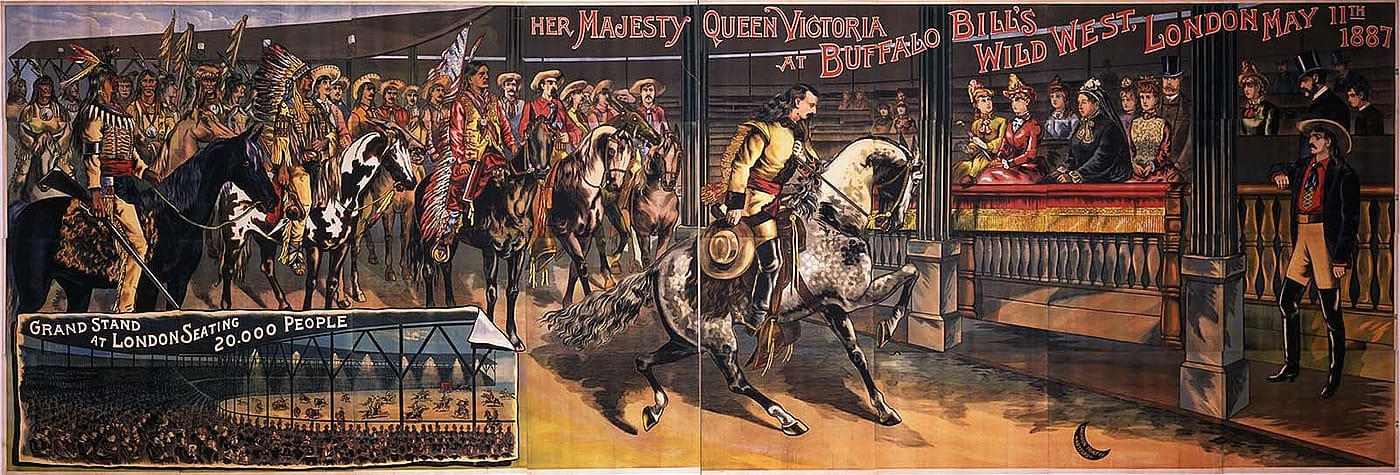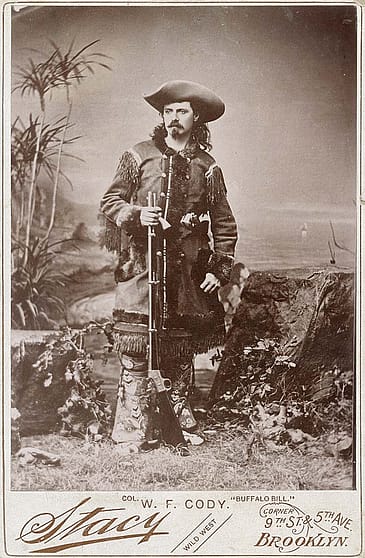Collections

Buffalo Bill Museum Collections

Mission and Purpose
Through its collections, the Buffalo Bill Museum presents the life and legacy of William F. “Buffalo Bill” Cody in order to increase awareness and knowledge of his impact on the historical and cultural development of the American West.
Museum Goals
- To emphasize the multidimensional quality of William F. Cody.
- To show the variety and quality of William F. Cody’s business and personal associates, acquaintances, employees, and friends, paying particular attention to both the “Buffalo Bill Combination” and the “Wild West” exhibition eras.
- To illustrate the settlement and development of the West, especially that of Wyoming, the Big Horn Basin region, and Cody.
- To present the American West as a place of the imagination as well as a geographical region.
- To provide a foundation for the expression and discussion of differing points of view concerning ideas, representations, and events of the West in all of its varying forms, both historical and contemporary.
- To document and present the folklore, vernacular arts, and popular culture of the American West, especially as an expression of its living heritage and as a reflection of its multicultural nature.
Collecting Priorities
The Buffalo Bill Museum seeks to collect artifacts, archival materials, photographs, artwork, memorabilia, and ephemera relating to and documenting the following areas:
- William F. Cody, his life and times, and his family.
- Individuals associated with Buffalo Bill, such as Annie Oakley, Iron Tail, Buck Taylor, Nate Salsbury, Johnny Baker, Texas Jack Omohundro, and other cast members and employees of Buffalo Bill’s Wild West and/or the Buffalo Bill Combination.
- Financial, logistical, operational, and promotional aspects of Buffalo Bill’s Wild West, the Buffalo Bill Combination, and competing enterprises of a similar nature.
- Individuals’ lives and work in the Rocky Mountain West and/or northern Great Plains, including ranching, farming, mining, and more.
- Social, economic, cultural, and community history, life, and conditions within Wyoming, especially with reference to the Big Horn Basin and the town of Cody.
- Folk, vernacular, and popular culture of the American West, including, though not limited to, saddles and other equestrian gear, apparel, dime novels, iconography, western memorabilia, promotional and tourism literature, and advertising artwork.
- Materials that augment collection strengths or otherwise support, enhance, or illuminate the interpretation of the Buffalo Bill Museum’s major themes.
Scope and Highlights

Numbering some 9,300 items, the collection of the Buffalo Bill Museum richly documents not only the life and times of William F. “Buffalo Bill” Cody and the history and operations of Buffalo Bill’s Wild West, but also the lived experiences of settlers, ranchers, farmers, cowboys, and other people in the interior West. Items range in size from very small—such as buttons, jewelry, and thimbles—to very large, such as wagons and stagecoaches and, largest of all, the “Boyhood Home” of William F. Cody, which the museum acquired in the 1930s.
With items dating back to his early childhood, the Buffalo Bill Museum possesses what is believed to be the largest and most comprehensive assemblages of artifacts relating to the life of William F. Cody. The collection contains more than three dozen firearms that Cody owned, used, or presented as gifts, including the remnants of “Lucretia Borgia” (1.69.366), the U.S. Springfield Model 1866 .50-caliber, trap-door type rifle that Cody used in hunting bison during the late 1860s and 1870s, earning for himself the nickname of “Buffalo Bill”; several of Cody’s .44-caliber Winchester Model 1873 rifles; and the .30-caliber Winchester Model 1895 saddle-ring carbine that he presented to his close friend, George Beck.

Other significant items relating to William F. Cody include his Congressional Medal of Honor, awarded for valorous service as a scout for the U.S. Army during the Indian Wars; his Wild West saddle, built for him in 1893 by the Omaha saddlery of Collins & Morrison; gold watches, jewelry, and other gifts presented to him by monarchs and heads of state; and furniture, household items, branding irons, and a chuck wagon from his TE Ranch southwest of Cody, Wyoming.

Buffalo Bill’s Wild West is represented in the collection through more than 200 original posters, ranging from single-sheet to multiple-sheet, billboard-sized, examples. Also included are jackets, hats, shirts, vests, boots, and gauntlets that Cody wore as star and impresario of Buffalo Bill’s Wild West, along with hats, boots, skirts, petticoats, chaps, and other clothing worn by Annie Oakley, Gordon “Pawnee Bill” Lillie, Johnny Baker, Orilla Downing, and other Wild West performers. The museum holds two “Deadwood” stagecoaches, manufactured by the Abbot Downing Company of Concord, New Hampshire, and used in performances of the Wild West. Musical instruments, firearms, targets, desks and chairs, games, props, souvenirs, and memorabilia round out the documentation of Buffalo Bill’s Wild West.
Other significant elements in the collection:
- Hundreds of examples of western apparel, ranging from suits, dresses, petticoats, and skirts, to hats, vests, chaps, gloves, gauntlets, shoes, and boots, dating from the early nineteenth to the late twentieth century, and embracing both “high-end” designer apparel and utilitarian clothing worn in everyday life.
- Nearly a hundred saddles, both fancy and utilitarian, representing a variety of styles, makers, regions, and cultural influences.
- The collection of Victor Alexander, a prominent saddle maker of the mid-twentieth century, numbering some 5,000 items and including tools, dies, patterns, and templates.
- An extensive assemblage of equestrian tack and gear, including spurs, spur covers, bridles, bits, headstalls, and harness.
- Tools and equipment used in the frontier and settlement periods, such as chuck, sheep, and mud wagons; wagon jacks, scales, hammers, saws, drills and augers, ropes, whips, quirts, knives, axes, branding irons, and barbed wire.
- Rodeo-related memorabilia, including posters, flags, apparel, souvenirs, and trophies.